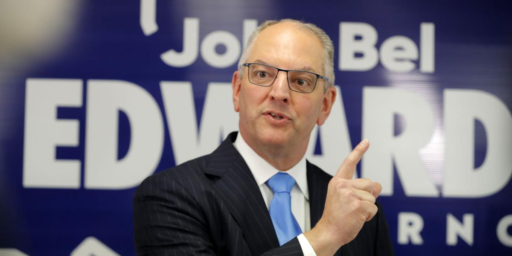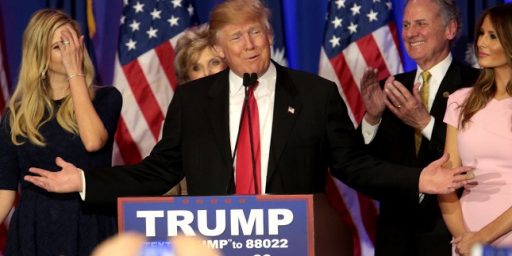Is Democratic Race ‘Close’?
Mathew Shugart examines often-heard claims that the race between Hillary Clinton and Barack Obama is “close.” He looks at the pledge delegate counts and sees Obama leading Clinton 52.4 percent to 47.6 percent and concludes, “I will grant that this lead is not a ‘landslide’ by any means. But, quite independent of any realism (or lack thereof) of catch-up scenarios, is a difference of almost 5 percentage points ‘close’?”
Actually, I’d say it is, at least when the races isn’t (technically) over yet. Further, part of the game has been trying to figure out the baselines. That is, percentage of what?
RealClearPolitics has added nearly 100 pledged delegates to the count since Shugart’s calculations yesterday. That brings it to 50.8 to 46.0 (1654/3253 to 1498/3253). That closes the gap slightly. And RCP assigns 9 pledged delegates from John Edwards to Obama. If those are excluded, which seems reasonable in terms of a first ballot if “pledged” means anything, then it’s even narrower (50.7 to 46.2).
If you add in the unpledged “superdelegates,” though, you get another set of numbers. RCP shows Obama with 307 and Clinton with 279. If you add them in and keep the Edwards delegates out, then it gets even closer, 51.6 to 47.7, a gap of 4 points.
Another way of looking at the same data is that Clinton has 90.9 percent the delegates Obama has. That’s pretty close, no? Especially in context of a race that so many have been saying she had a duty to withdraw from weeks ago.
Now, if we add in Florida and Michigan . . . .
Ultimately, though, it’s not the actual closeness of the race that matters but the perception of it. A month ago, the press played along with the idea that Clinton could overtake Obama, despite it being unlikely. She’s closed the gap substantially since then but, alas, not enough. Even though neither is likely to have enough delegates wrapped up to win going into the convention, the near-universal sentiment is that he is the winner and is owed the nomination. Absent a scandal of monumental proportions, I can’t see how Clinton overturns that.
via Steven Taylor





In a general election, would we say a 52% to 48% victory was close?
We would if it was similarly close in the Electoral College, I think. If it was an EC blowout, not so much.
Certainly, though, if the polls were showing it 52-48 in October, we’d think it was “close.”
The other side of this is the potential for change between now and the convention. Or to put it another way, how many times does Obama have to say that Iran is not a serious threat on one day and then say Iran is a grave threat the next day. At some point the adults in the democratic party say enough is enough, Obama is not ready to be president. The question is how many adults do you need to find to switch from Obama to Clinton. Assuming a 5% spread between them, that represents about 220 delegates of all sorts (super and non-super aren’t locked into their results).
A more cynical way of looking at it is if Clinton can buy ~220 delegates belonging to Obama. How many ambassadorships are their?
Hillarity Clinton shouldn’t take this abuse.
I say she should run as a third party candidate!
What exactly in the history of the Democratic party would make you think this is possible?
Michael,
That is why I put in the qualifier of whether there are 220 adults among the delegates who would make the switch.